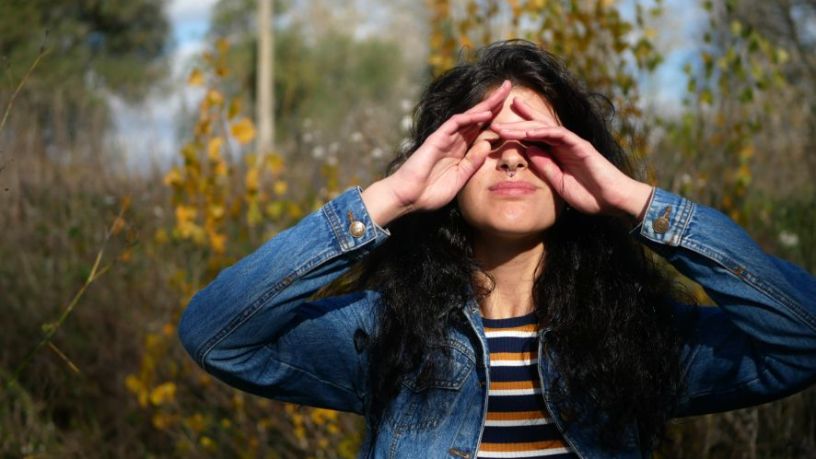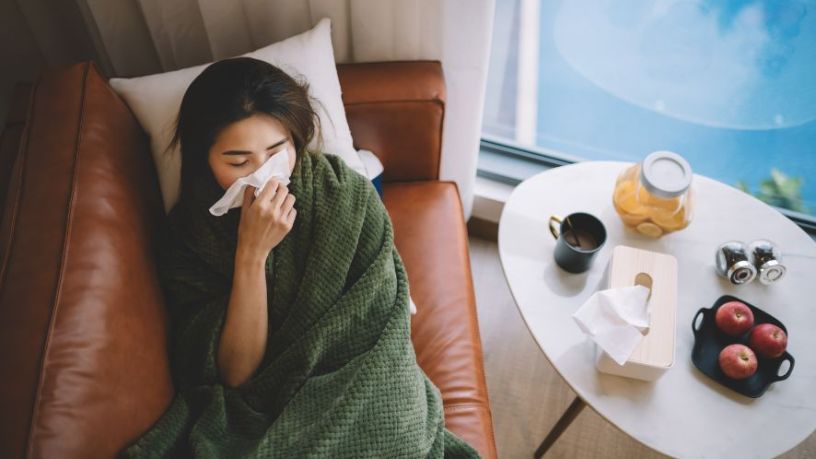Allergic rhinitis (commonly known as hay fever) affects almost one in 3 children.
On this page
Key takeaways
It’s caused by environmental factors like dust and pollen.
Hay fever can usually be well managed in children with the right approach.
Hay fever is common in Australia, affecting up to 30% of children.1
Allergic rhinitis isn’t caused by food, it’s a reaction to an allergen in the environment.
Common triggers include:
- dust mites
- pet dander (skin, saliva and fur)
- grass
- pollen
- mould.
Knowing how to recognise and reduce hay fever symptoms can help keep your child safe and comfortable.
Why do children get allergies?
When you develop an allergy it’s because your immune system has identified something that is harmless to most people as a potential threat, causing a reaction.
“While the type of allergy we get isn’t genetic, having one or more parents who have an allergy does increase the risk of developing an allergy too,” says Dr Lara Ford, clinical immunology and allergy specialist at The Children’s Hospital at Westmead.2
Other risk factors may include heritage, cultural practices and environmental aspects such as location and proximity to certain airborne allergens like pollen.3
“You have to be exposed to an allergen to develop an allergy,” says Dr Ford. “That may be why dust mite allergy is more likely to develop in toddlers and pre-schoolers who are in the home more and constantly exposed, whereas grass allergies are more commonly seen developing in school age children.”
While changes in weather don’t cause allergies, there may be a spike in symptoms on very windy or rainy days due to allergens such as tree or grass pollens being suddenly distributed into the atmosphere.4
What does an allergic reaction look like?
Allergic reactions to dust or pets can vary from very mild to extremely severe.
Common symptoms include:
- sneezing
- an itchy, runny nose
- itchy, watery eyes
- an itchy throat, and/or need to clear the throat
- a blocked nose that sometimes causes mouth breathing and snoring.5
Anaphylaxis is the most serious type of allergic reaction and is not caused by allergic rhinitis.
Treating hay fever symptoms
Even very mild symptoms can cause problems and are worth treating, says Dr Ford.
“Untreated allergic rhinitis can impact sleep quality, the ability to concentrate at school or take part in sports and other activities,” she says.
Life quality can be improved with the right management approach.
Physically, if left untreated in children, allergic rhinitis can also cause other health issues, such as ear infections.5
For allergic rhinitis, there are 3 stages of treatment available.
1. Avoidance
If you know what your child is allergic to, you may be able to help them avoid it. This can be harder for some families than others.
“It’s hard to tell people to get rid of their animals even if they’re allergic, they’re family members!” says Dr Ford. “However, keeping the cat out of the child’s bedroom, and definitely off the bed, can help reduce symptoms. It might also be a good idea if the child doesn’t play with or touch the cat after bath time once they’re in their PJs”.
Dust mite and grass allergies can also be hard to avoid altogether, although reduction in exposure can help.
“With dust mites and kids, the number one way to reduce exposure is in the bedroom,” says Dr Ford. “A bed is dust mite heaven: warm, dark and humid, and our faces are buried in it for hours at night. Investing in dust mite covers for items of bedding that can’t be washed (pillows, mattress and doonas), that are a tighter weave than general fabrics and harder for dust mites to get through, can help. Bed linen should be washed weekly in hot water.”
Other ways to reduce dust mites in the bedroom are to remove soft toys and decorative pillows, and to damp dust and vacuum regularly.
To reduce exposure to pollen or grass seed:
- close windows on windy days
- keep hair tied back and under a cap while outside
- wipe down your child’s face and change their clothes after being outside.
2. Medication
“Antihistamines and intranasal corticosteroids (nasal sprays) are well tolerated and safe for use in children with allergic rhinitis and work regardless of the allergic trigger,” says Dr Ford.
Decongestants (taken either by mouth or as a nasal spray) are not appropriate for long-term management of allergic rhinitis. Speak to your GP about what is suitable for your child and their age and needs.
Get chemist delivery
Bupa health insurance members can have prescriptions filled by local chemists and get them delivered to their door by registered couriers. You can also order over-the-counter goods. Delivery address must be within 8km of a participating pharmacy.
3. Allergen immunotherapy
Treatment involves exposing your child to their allergen regularly (either orally or by injection) over a period lasting up to several years to help the body to stop seeing the allergen as a threat and help reduce or stop symptoms.6
Speak to your GP or allergy specialist to find out if this approach is right for your child.
Should I have my child tested for allergies?
“Whether you choose to have your child allergy tested is really about how you want to treat the symptoms” says Dr Ford.
“If you have a good idea about what sets off your child’s allergies from when their symptoms present then the only reason to have them tested is if you’re going to manage it differently from the way you currently are.”
For example, if your child wakes up sneezy in the mornings all year round but is usually okay by the time they head off to school, they may have a dust mite allergy. Alternatively, if they are only showing symptoms during spring, they may have a pollen or grass seed allergy.
These symptoms may be reduced or managed with avoidance and/or medications that your GP can recommend.
“If you want to pursue allergen immunotherapy, which is the best approach for long-term, definitive outcomes, you will need an allergy test so the treating doctor knows exactly what allergens affect you,” says Dr Ford.
Resources
Allergy & Anaphylaxis Australia has online support resources available. You can also call for help and support on 1300 728 000.
Allergy 250K provides support for teenagers and young adults.

At Bupa, trust is everything
Our health and wellbeing information is regularly reviewed and maintained by a team of healthcare experts, to ensure its relevancy and accuracy. Everyone's health journey is unique and health outcomes vary from person to person.
This content is not a replacement for personalised and specific medical, healthcare, or other professional advice. If you have concerns about your health, see your doctor or other health professional.
1The Royal Children’s Hospital Melbourne. (2021). Kids Health Information: Hay fever. The Royal Children’s Hospital Melbourne.
2American College of Allergy, Asthma & Immunology. (2022). Who gets Allergies?. American College of Allergy, Asthma & Immunology.
3Krempski, J., Dant, C., & Nadeau, K. (2020). The origins of allergy from a systems approach. Annals of Allergy, Asthma & Immunology, 125(5), 507-516.
4Victoria State Government, Department of Health. (2018). Thunderstorm Asthma. Victoria State Government, Department of Health.
5Australasian Society of Clinical Immunology and Allergy. (2024). Allergic Rhinitis (Hay Fever) Frequently Asked Questions. Australasian Society of Clinical Immunology and Allergy.
6Australasian Society of Clinical Immunology and Allergy. (2024). Allergen Immunotherapy. Australasian Society of Clinical Immunology and Allergy.
You might also like...
Your guide to hay fever medications and remedies
We look at ways to help people with hay fever reduce symptoms with remedies such as medications and lifestyle changes.
Allergies: What they are, why you get them and what to do
Allergies are common in Australia, but many people don’t get diagnosed or treated properly. Find out how you can manage some common allergies.
Asthma, hay fever and eczema: What you need to know
Allergic diseases such as asthma, eczema and hay fever often occur together. Learn about each condition and how to manage it.
Hay fever: A quick guide
You might deal with hay fever every year, but how much do you actually know about the allergic condition? Discover the basics with this quick guide.





